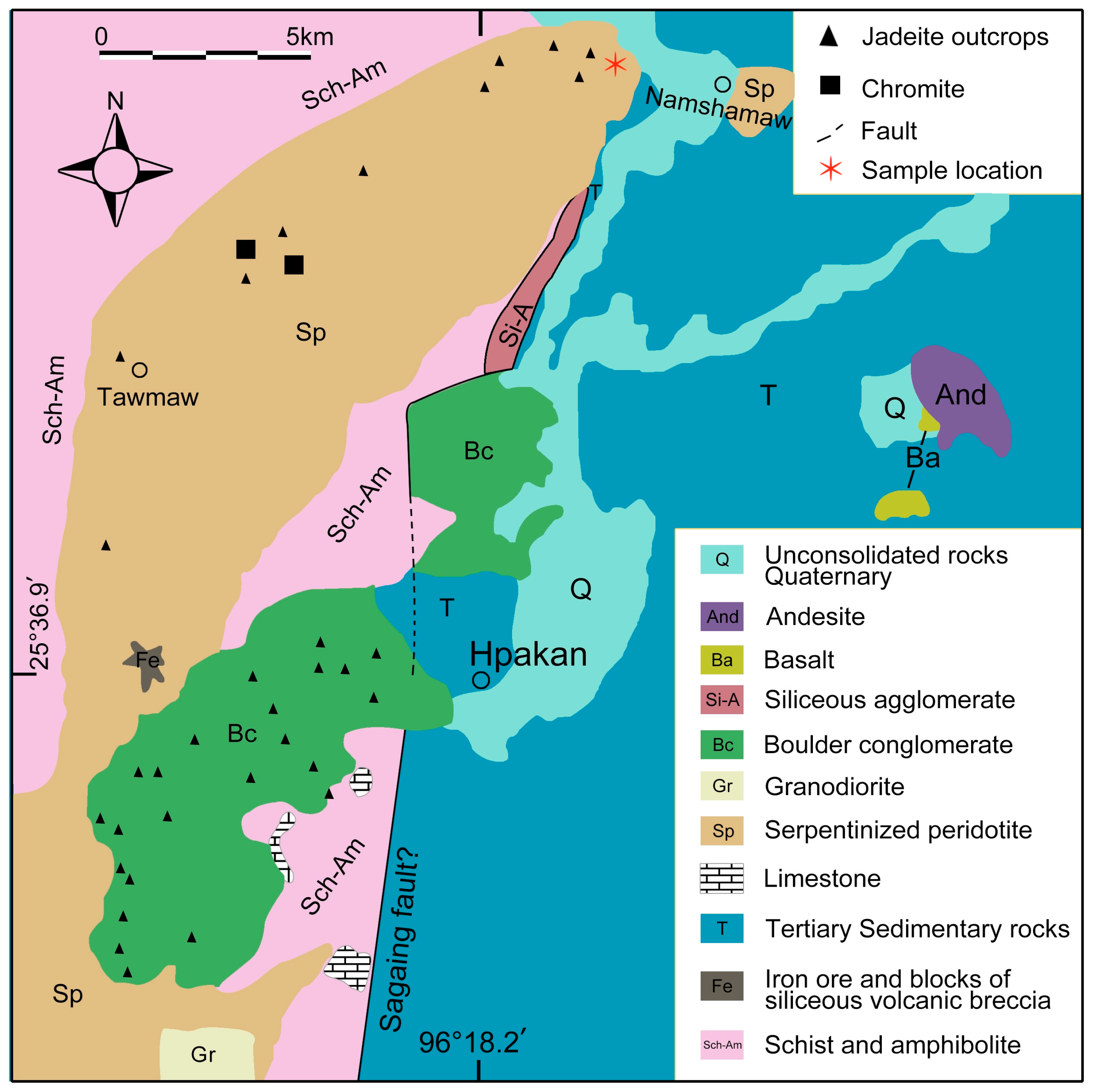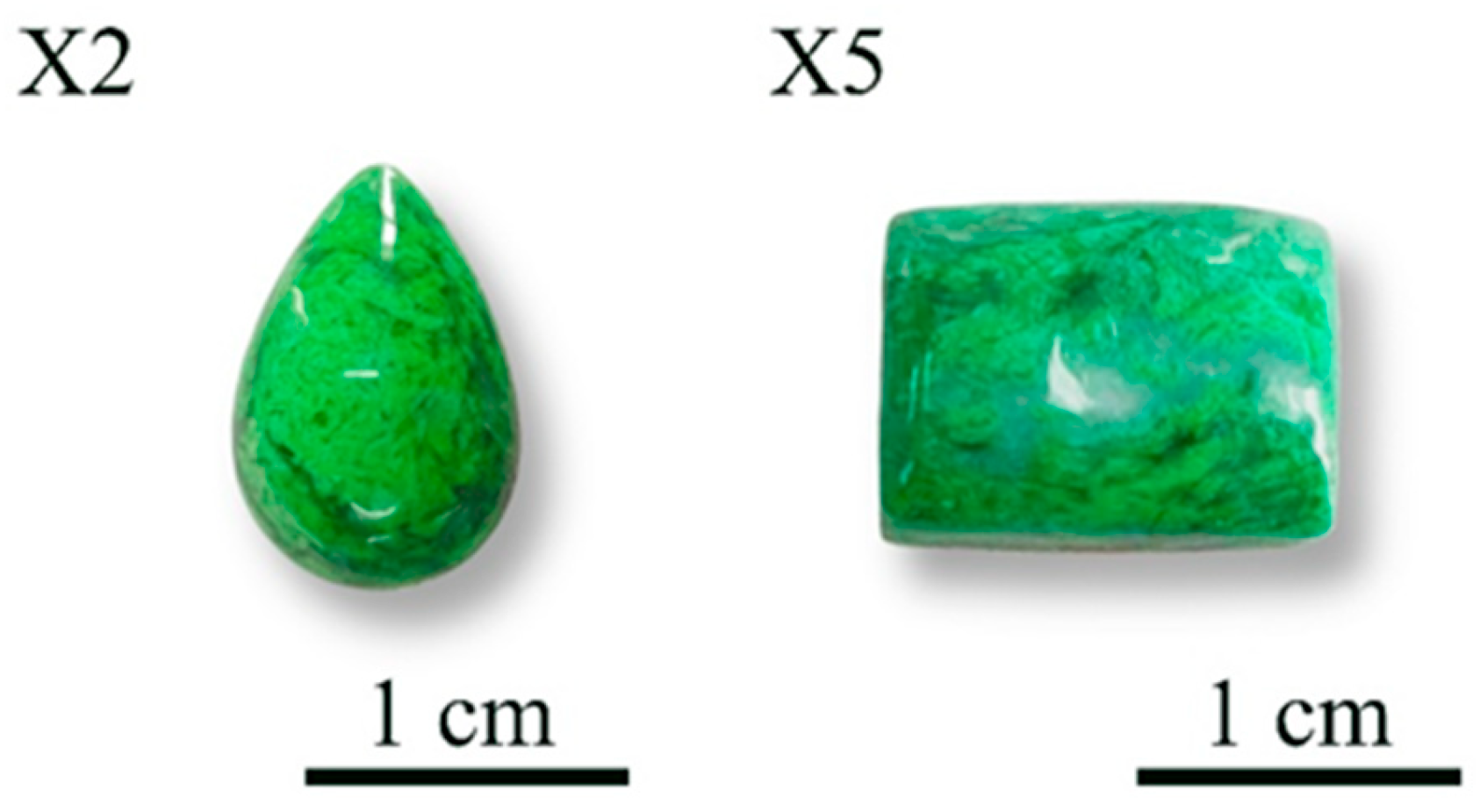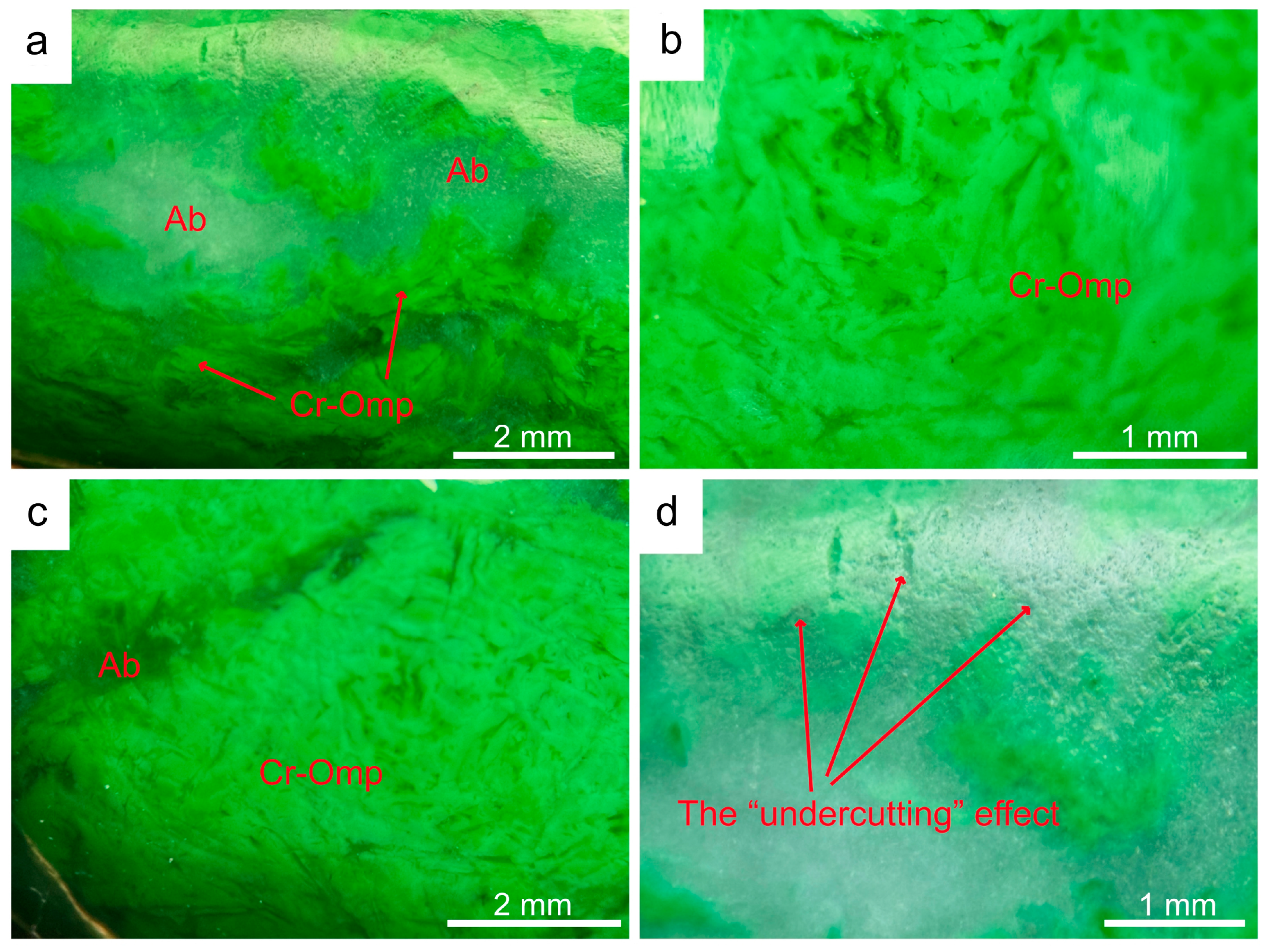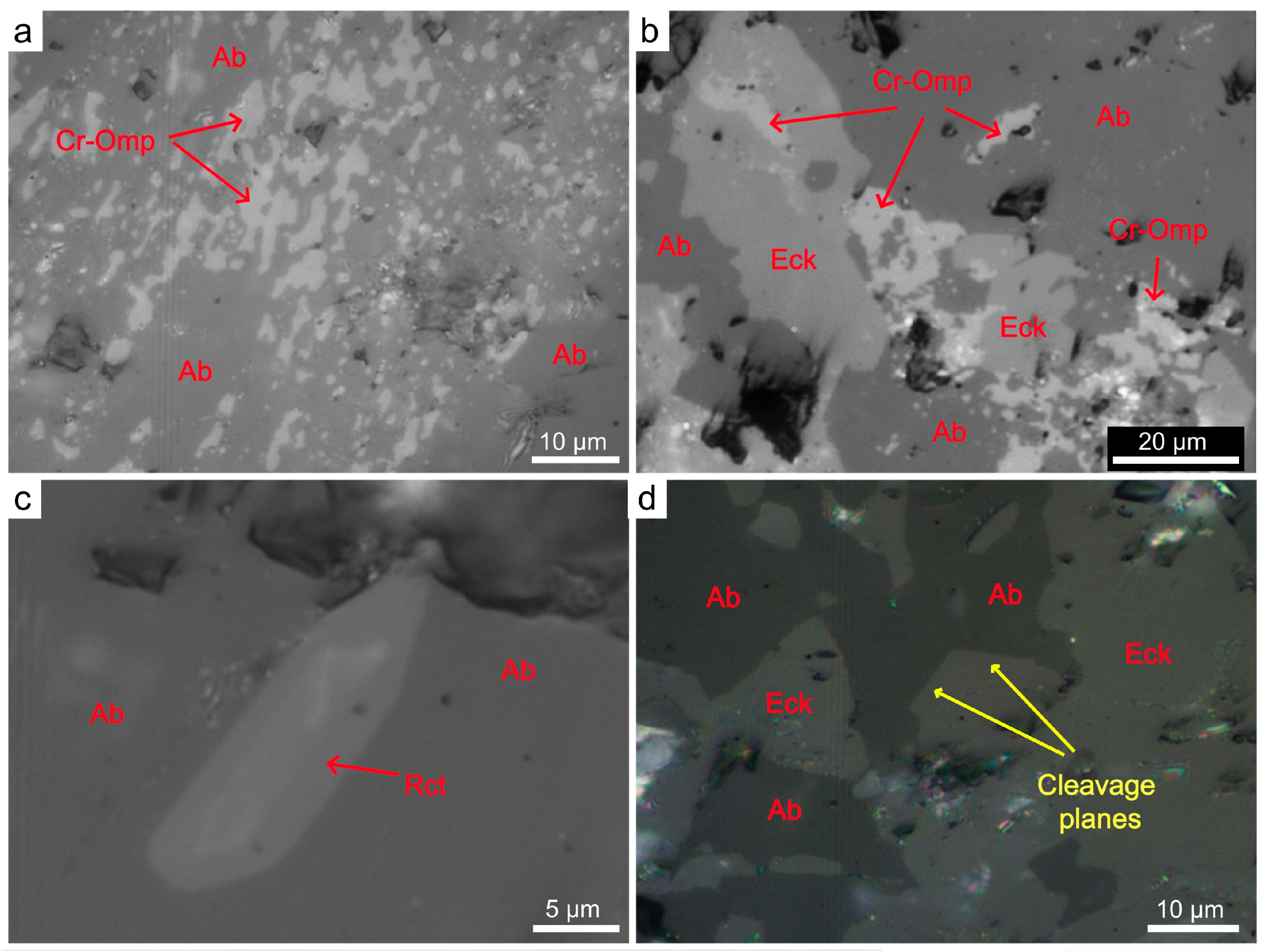Mineralogical, Gemological Characteristics and Petrogenesis of High-Quality Maw-Sit-Sit Jade from the Myanmar Jade Belt
Abstract
1. Introduction
2. Geological Setting
3. Materials and Methods
3.1. Sample Selection and Preparation
3.2. Methods
4. Results
4.1. Gemological Characteristics
4.2. Petrography
4.3. Mineral Chemistry
5. Discussion
5.1. Composition Characteristics of Cr-Omphacite in Maw-Sit-Sit Jade
5.2. Mineral Composition and Mineral Genesis Sequence
5.3. The Formation Process of Maw-Sit-Sit Jade
5.4. Identification of Maw-Sit-Sit Jade
6. Conclusions
Author Contributions
Funding
Data Availability Statement
Acknowledgments
Conflicts of Interest
References
- Shi, G.; Harlow, G.E.; Wang, J.; Wang, J.; Enoch, N.G.; Wang, X.; Cao, S.M.; Enyuancui, W. Mineralogy of jadeitite and related rocks from Myanmar: A review with new data. Eur. J. Mineral. 2012, 24, 345–370. [Google Scholar] [CrossRef]
- Searle, M.P.; Palin, R.M.; Gardiner, N.J.; Htun, K.; Wade, J. The Burmese Jade Mines belt: Origins of jadeitites, serpentinites, and ophiolitic peridotites and gabbros. J. Geol. Soc. 2023, 180, jgs2023-004. [Google Scholar] [CrossRef]
- Zhang, Y.; Shi, G. Origin of Blue-Water Jadeite Jades from Myanmar and Guatemala: Differentiation by Non-Destructive Spectroscopic Techniques. Crystals 2022, 12, 1448. [Google Scholar] [CrossRef]
- Gübelin, E. Maw-sit-sit—A new decorative gemstone from Burma. J. Gemmol. 1965, 9, 329–344. [Google Scholar] [CrossRef]
- Hänni, H.A.; Meyer, J. Maw-sit-sit (kosmochlor jade): A metamorphic rock with a complex composition from Myanmar (Burma). In Proceedings of the 26th International Gemmological Conference, Idar-Oberstein, Germany, 27 September–3 October 1998; pp. 22–24. [Google Scholar]
- Colombo, F.; Rinaudo, C.; Trossarelli, C. The mineralogical composition of maw-sit-sit from Myanmar. J. Gemmol. 2000, 27, 87–92. [Google Scholar] [CrossRef]
- Nyunt, T.T. Petrological and Geochemical Contribution to the Origin of Jadeitite and Associated Rocks of the Tawmaw Area, Kachin State, Myanmar. Ph.D. Thesis, University of Stuttgart, Stuttgart, Germany, 2009. [Google Scholar]
- Zhang, Y.; Shi, G.; Wen, J. Chromite and Its Thin Kosmochlor and Cr-Omphacite Cortex in Amphibolite from the Myanmar Jadeite Deposits. Crystals 2025, 15, 79. [Google Scholar] [CrossRef]
- Mével, C.; Kienast, J.-R. Jadeite-kosmochlor solid solution and chromian sodic amphiboles in jadeitites and associated rocks from Tawmaw (Burma). Bull. Minéral. 1986, 109, 617–633. [Google Scholar] [CrossRef]
- Harlow, G.E.; Olds, E.P. Observations on terrestrial ureyite and ureyitic pyroxene. Am. Mineral. 1987, 72, 126–136. [Google Scholar] [CrossRef]
- Hughes, R.W.; Galibert, O.; Bosshart, G.; Ward, F.; Oo, T.; Smith, M.; Sun, T.T.; Harlow, G.E. Burmese jade: The inscrutable gemstone. Gems. Gemol. 2000, 36, 2–26. [Google Scholar] [CrossRef]
- Mitchell, A.; Htay, M.T.; Htun, K.M. Middle Jurassic arc reversal, Victoria–Katha Block and Sibumasu Terrane collision, jadeite formation and Western Tin Belt generation, Myanmar. Geol. Mag. 2021, 158, 1487–1503. [Google Scholar] [CrossRef]
- Mitchell, A. Jade Mines–Loimaw Uplift. In Geological Belts, Plate Boundaries, and Mineral Deposits in Myanmar; Elsevier: Amsterdam, The Netherlands, 2018; pp. 439–460. [Google Scholar] [CrossRef]
- Morley, C.K.; Naing, T.T.; Searle, M.; Robinson, S.A. Structural and tectonic development of the Indo-Burma ranges. Earth-Sci. Rev. 2020, 200, 102992. [Google Scholar] [CrossRef]
- Harlow, G.E.; Tsujimori, T.; Sorensen, S.S. Jadeitites and Plate Tectonics. Annu. Rev. Earth Planet. Sci. 2015, 43, 105–138. [Google Scholar] [CrossRef]
- Gem-A, The Gemmological Association of Great Britain. The Diploma in Gemmology Course. Gem-A, The Gemmological Association of Great Britain: London, UK, 2009; pp. 4–15. [Google Scholar]
- Warr, L.N. IMA–CNMNC approved mineral symbols. Miner. Mag. 2021, 85, 291–320. [Google Scholar] [CrossRef]
- Johnson, C.A.; Harlow, G.E. Guatemala jadeitites and albitites were formed by deuterium-rich serpentinizing fluids deep within a subduction zone. Geology 1999, 27, 629–632. [Google Scholar] [CrossRef]
- Harlow, G.; Sisson, V.; Sorensen, S. Jadeitite from Guatemala: New observations and distinctions among multiple occurrences. Geol. Acta 2011, 9, 363–387. [Google Scholar] [CrossRef]
- Harlow, G.E.; Quinn, E.P.; Rossman, G.R.; Rohtert, W.R. Blue omphacite from Guatemala. Gems. Gemol. 2004, 40, 68–70. [Google Scholar]
- Skelton, R.; Walker, A.M. The effect of cation order on the elasticity of omphacite from atomistic calculations. Phys. Chem. Miner. 2015, 42, 677–691. [Google Scholar] [CrossRef]
- Flores, K.E.; Martens, U.C.; Harlow, G.E.; Brueckner, H.K.; Pearson, N.J. Jadeitite formed during subduction: In situ zircon geochronology constraints from two different tectonic events within the Guatemala Suture Zone. Earth Planet. Sci. Lett. 2013, 371–372, 67–81. [Google Scholar] [CrossRef]
- Reznitsky, L.Z.; Sklyarov, E.V.; Galuskin, E.V. Complete isomorphic join diopside–kosmochlor CaMgSi2O6–NaCrSi2O6 in metamorphic rocks of the Sludyanka complex (southern Baikal region). Russ. Geol. Geophys. 2011, 52, 40–51. [Google Scholar] [CrossRef]
- Morimoto, N. Nomenclature of Pyroxenes. Miner. Pet. 1988, 39, 55–76. [Google Scholar] [CrossRef]
- Franz, L.; Sun, T.T.; Hanni, H.A. A Comparative Study of Jadeite, Omphacite and Kosmochlor Jades from Myanmar, and Suggestions for a Practical Nomenclature. J. Gemmol. 2014, 34, 210–229. [Google Scholar] [CrossRef]
- Frondel, C.; Klein, C. Ureyite, NaCrSi2O6: A New Meteoritic Pyroxene. Science 1965, 149, 742–744. [Google Scholar] [CrossRef]
- Couper, A.G.; Hey, M.H.; Hutchison, R. Cosmochlore—A new examination. Miner. Mag. 1981, 44, 265–267. [Google Scholar] [CrossRef]
- Greshake, A.; Bischoff, A. Chromium-bearing Phases in Orgueil (CI): Discovery of Magnesiochromite (MgCr2O4), Ureyite (NaCrSi2O6), and ChromiumOxide (Cr2O3). Lunar Planet. Sci. 1996, 27, 461–462. [Google Scholar]
- Ouyang, C.M. A terrestrial source of ureyite. Am. Mineral. 1984, 69, 1180–1183. [Google Scholar] [CrossRef]
- Dobretsov, N.L.; Tatarinov, A.V. Jadeite and Nephrite in Ophiolite from West Sayan; Nauka Press: Novosibirsk, Russia, 1983; p. 125. [Google Scholar]
- Sakamoto, S.; Takasu, A. Kosmochlor from the Osayama ultramafic body in the Sangun metamorphic belt, southewest Japan. J. Geol. Soc. Jpn. 1996, 102, 49–52. [Google Scholar] [CrossRef]
- Akira, T.; Yasumitsu, S.; Yoshiya, O.; Takahiko, O.; Shizue, S. Newly identified end-member kosmochlor from the Yamanobo outcrop of the Renge metamorphic belt, Itoigawa, central Japan. Earth Sci. J. 2022, 76, 37–42. [Google Scholar] [CrossRef]
- Ouyang, C.M.; Qi, L.J. Hte long sein—A new variety of chrome jadeite jade. J. Gemmol. 2001, 27, 321–327. [Google Scholar] [CrossRef]
- Xing, Y.; Qi, L. Compositional zoning and evolution of symplectite coronas in jadeitite. Mater. Test. 2024, 66, 1207–1218. [Google Scholar] [CrossRef]
- Zhang, Y.; Shi, G.; Wen, J. Manganese-Rich Chromite in Myanmar Jadeite Jade: A Critical Source of Chromium and Manganese and Its Role in Coloration. Crystals 2025, 15, 704. [Google Scholar] [CrossRef]
- Oberti, R.; Boiocchi, M.; Hawthorne, F.C.; Ball, N.A.; Harlow, G.E. Eckermannite revised: The new holotype from the Jade Mine Tract, Myanmar—Crystal structure, mineral data, and hints on the reasons for the rarity of eckermannite. Am. Mineral. 2015, 100, 909–914. [Google Scholar] [CrossRef]
- Shi, G.-H.; Cui, W.-Y.; Tropper, P.; Wang, C.-Q.; Shu, G.-M.; Yu, H. The petrology of a complex sodic and sodic?calcic amphibole association and its implications for the metasomatic processes in the jadeitite area in northwestern Myanmar, formerly Burma. Contrib. Miner. Pet. 2003, 145, 355–376. [Google Scholar] [CrossRef]
- Cathelineau, M. Accessory mineral alteration in peraluminous granites at the hydrothermal stage: A review. Rend. Soc. Ital. Mineral. Petrol 1988, 43, 499–508. [Google Scholar]
- Yang, L.; Deng, J.; Guo, C.; Zhang, J.; Jiang, S.; Gao, B.; Gong, Q.; Wang, Q. Ore-Forming Fluid Characteristics of the Dayingezhuang Gold Deposit, Jiaodong Gold Province, China. Resour. Geol. 2009, 59, 181–193. [Google Scholar] [CrossRef]
- Sun, X.; Deng, J.; Zhao, Z.; Zhao, Z.; Wang, Q.; Yang, L.; Gong, Q.; Wang, C. Geochronology, petrogenesis and tectonic implications of granites from the Fuxin area, Western Liaoning, NE China. Gondwana Res. 2010, 17, 642–652. [Google Scholar] [CrossRef]
- Schwartz, M.O. Geochemical criteria for distinguishing magmatic and metasomatic albite-enrichment in granitoids—Examples from the tantalum-lithium granite Yichun (China) and the tin-tungsten deposit Tikus (Indonesia). Miner. Deposita 1992, 27, 101–108. [Google Scholar] [CrossRef]
- Harlow, G.E.; Flores, K.E.; Marschall, H.R. Fluid-mediated mass transfer from a paleosubduction channel to its mantle wedge: Evidence from jadeitite and related rocks from the Guatemala Suture Zone. Lithos 2016, 258–259, 15–36. [Google Scholar] [CrossRef]
- Angiboust, S.; Glodny, J.; Cambeses, A.; Raimondo, T.; Monié, P.; Popov, M.; Garcia-Casco, A. Drainage of subduction interface fluids into the forearc mantle evidenced by a pristine jadeitite network (Polar Urals). J. Metamorph. Geol. 2020, 39, 473–500. [Google Scholar] [CrossRef]
- Chen, Y.; Huang, F.; Shi, G.-H.; Wu, F.-Y.; Chen, X.; Jin, Q.-Z.; Su, B.; Guo, S.; Sein, K.; Nyunt, T.T. Magnesium Isotope Composition of Subduction Zone Fluids as Constrained by Jadeitites From Myanmar. J. Geophys. Res. Solid Earth 2018, 123, 7566–7585. [Google Scholar] [CrossRef]
- Shigeno, M.; Mori, Y.; Nishiyama, T. Reaction microtextures in jadeitites from the Nishisonogi metamorphic rocks, Kyushu, Japan. J. Mineral. Petrol. Sci. 2007, 100, 237–246. [Google Scholar] [CrossRef]
- Compagnoni, R.; Rolfo, F.; Castelli, D. Jadeitite from the Monviso meta-ophiolite, western Alps: Occurrence and genesis. Eur. J. Mineral. 2012, 24, 333–343. [Google Scholar] [CrossRef]
- Mori, Y.; Orihashi, Y.; Miyamoto, T.; Shimada, K.; Shigeno, M.; Nishiyama, T. Origin of zircon in jadeitite from the Nishisonogi metamorphic rocks, Kyushu, Japan. J. Metamorph. Geol. 2011, 29, 673–684. [Google Scholar] [CrossRef]
- Tsujimori, T.; Harlow, G.E. Petrogenetic relationships between jadeitite and associated high-pressure and low-temperature metamorphic rocks in worldwide jadeitite localities: A review. Eur. J. Mineral. 2012, 24, 371–390. [Google Scholar] [CrossRef]
- Chen, A.-X.; Chen, X.; Chen, Y.; Han, X.-Q.; Wang, Y.-J.; Huang, F. Low-δ56Fe fluid released from serpentinite as recorded by iron isotopes of Myanmar jadeitites. Chem. Geol. 2023, 639, 121730. [Google Scholar] [CrossRef]
- Sorensen, S.S.; Harlow, G.E.; Rumble, D.I. The origin of jadeitite-forming subduction-zone fluids: CL-guided SIMS oxygen-isotope and trace-element evidence. Am. Mineral. 2006, 91, 979–996. [Google Scholar] [CrossRef]
- Kawamoto, T.; Hertwig, A.; Schertl, H.-P.; Maresch, W.V. Fluid inclusions in jadeitite and jadeite-rich rock from serpentinite mélanges in northern Hispaniola: Trapped ambient fluids in a cold subduction channel. Lithos 2018, 308–309, 227–241. [Google Scholar] [CrossRef]
- Minnaert, C.; Angiboust, S.; Herviou, C.; Melis, R.; Glodny, J.; Cambeses, A.; Raimondo, T.; Payne, J.; Rigaudier, T.; Cárdenas-Párraga, J.; et al. Tracking fluid sources in mantle wedge jadeitites: Petro-geochemical constraints and implications for fluid venting above the subduction interface. Chem. Geol. 2025, 695, 123046. [Google Scholar] [CrossRef]
- Chen, A.-X.; Li, Y.-H.; Chen, Y.; Yu, H.-M.; Huang, F. Silicon isotope composition of subduction zone fluids as recorded by jadeitites from Myanmar. Contrib. Miner. Pet. 2019, 175, 6. [Google Scholar] [CrossRef]
- Shi, G.; Lei, W.; He, H.; Ng, Y.N.; Liu, Y.; Liu, Y.; Yuan, Y.; Kang, Z.; Xie, G. Superimposed tectono-metamorphic episodes of Jurassic and Eocene age in the jadeite uplift, Myanmar, as revealed by 40Ar/39Ar dating. Gondwana Res. 2014, 26, 464–474. [Google Scholar] [CrossRef]
- Harlow, G.E. Jadeitites, albitites and related rocks from the Motagua Fault Zone, Guatemala. J. Metamorph. Geol. 1994, 12, 49–68. [Google Scholar] [CrossRef]
- Hirajima, T. Jadeite and jadeitite-bearing rock in the Sanbagawa and the Kamuikotan belts, Japan: A review(Review). J. Mineral. Petrol. Sci. 2017, 112, 237–246. [Google Scholar] [CrossRef]
- Wang, J.; Shi, G.; Wang, J.; Yuan, Y.; Yang, M. Hydrothermal albitite from the Myanmar jadeite deposit. Acta Petrol. Sin. 2013, 29, 1450–1460. [Google Scholar]








| Sample | Color | Shape | Specific Gravity | RI | UV Fluorescence | Descriptions |
|---|---|---|---|---|---|---|
| X2 | Bright green, partly whitepartly white and black. | Drop-shaped cabochon | 2.73 | 1.56 | SW: medium blue-white. LW: Weak. | The green Cr-omphacite is dominant, with a small amount of white albite and black-green amphibole. |
| X5 | Bright green, partly white. | Rectangular cabochon | 2.69 | 1.55 | SW: medium blue-white. LW: Weak. | The white albite and green Cr-omphacite are dominant, with a small amount of black-green amphibole. |
| Samples | X2-40 | X2-41 | X2-46 | X2-51 | X2-52 |
|---|---|---|---|---|---|
| SiO2 | 68.89 | 69.07 | 68.64 | 68.72 | 68.93 |
| TiO2 | nd | nd | 0.11 | 0.05 | nd |
| Al2O3 | 18.93 | 18.64 | 16.79 | 18.84 | 19.3 |
| Cr2O3 | nd | 0.22 | 1.37 | 0.53 | 0.04 |
| FeOtot | 0.01 | 0.08 | 0.46 | 0.25 | 0.06 |
| NiO | nd | 0.04 | 0.03 | 0.02 | 0.03 |
| MgO | nd | 0.03 | 0.4 | 0.11 | 0.02 |
| MnO | 0.02 | nd | nd | 0.02 | nd |
| CaO | nd | 0.05 | 0.59 | 0.16 | 0.01 |
| BaO | 0.04 | nd | 0.04 | nd | 0.01 |
| Na2O | 11.5 | 11.13 | 10.99 | 11.38 | 11.43 |
| K2O | 0.03 | 0.24 | 0.02 | 0.02 | 0.02 |
| Total | 99.43 | 99.5 | 99.43 | 100.11 | 99.84 |
| Si | 3.02 | 3.03 | 3.05 | 3.01 | 3.02 |
| Al | 0.98 | 0.96 | 0.88 | 0.97 | 1.00 |
| Cr | nd | 0.01 | 0.04 | 0.01 | nd |
| Mg | nd | nd | 0.03 | 0.01 | nd |
| Fe3+ | nd | nd | 0.02 | 0.01 | nd |
| Ca | nd | nd | 0.03 | 0.01 | nd |
| Na | 0.98 | 0.95 | 0.95 | 0.97 | 0.97 |
| K | nd | 0.01 | nd | nd | nd |
| Sum | 4.98 | 4.97 | 4.99 | 5.00 | 5.00 |
| Samples | X2-43 | X2-50 |
|---|---|---|
| SiO2 | 55.37 | 55.85 |
| TiO2 | 1.19 | 1.23 |
| Al2O3 | 4.57 | 5.07 |
| Cr2O3 | 13.21 | 11.01 |
| FeOtot | 5.21 | 5.62 |
| NiO | nd | 0.01 |
| MgO | 3.72 | 4.72 |
| MnO | 0.06 | 0.02 |
| CaO | 4.99 | 5.93 |
| Na2O | 11.20 | 10.63 |
| K2O | nd | 0.01 |
| Total | 99.51 | 100.10 |
| Si | 2.03 | 2.03 |
| Ti | 0.03 | 0.03 |
| Al | 0.20 | 0.22 |
| Cr | 0.38 | 0.32 |
| Fe3+ | 0.09 | 0.09 |
| Mg | 0.20 | 0.26 |
| Fe2+ | 0.07 | 0.08 |
| Ca | 0.20 | 0.23 |
| Na | 0.80 | 0.75 |
| Sum | 4.00 | 4.00 |
| Jd | 15.05 | 19.22 |
| WEF | 22.89 | 27.37 |
| Kos | 38.30 | 31.60 |
| Aeg | 23.76 | 21.81 |
| Samples | X2-42 | X2-44 | X2-47 | X2-48 |
|---|---|---|---|---|
| Eck | Rct | Rct | Rct | |
| SiO2 | 61.07 | 59.77 | 59.94 | 59.46 |
| TiO2 | 0.06 | 0.14 | 0.09 | 0.20 |
| Al2O3 | 8.79 | 1.43 | 1.31 | 0.97 |
| Cr2O3 | 3.57 | 4.15 | 2.91 | 4.77 |
| FeOtot | 2.09 | 3.56 | 4.14 | 3.55 |
| NiO | 0.07 | 0.07 | 0.07 | 0.07 |
| MgO | 10.49 | 17.00 | 18.34 | 17.00 |
| MnO | 0.02 | 0.06 | 0.09 | 0.09 |
| CaO | 0.40 | 1.93 | 1.93 | 2.03 |
| Na2O | 10.28 | 9.32 | 9.45 | 9.38 |
| K2O | 0.19 | 0.24 | 0.15 | 0.26 |
| Total | 97.04 | 97.66 | 98.41 | 97.79 |
| Si | 8.00 | 8.00 | 8.00 | 8.00 |
| Sum T | 8.00 | 8.00 | 8.00 | 8.00 |
| Al | 1.40 | 0.23 | 0.21 | 0.16 |
| Si | 0.26 | 0.24 | 0.2 | 0.31 |
| Ti | 0.01 | 0.01 | 0.01 | 0.02 |
| Cr | 0.38 | 0.45 | 0.32 | 0.52 |
| Fe2+ | 0.24 | 0.41 | 0.47 | 0.41 |
| Mn | nd | 0.01 | 0.01 | 0.01 |
| Mg | 2.11 | 3.49 | 3.74 | 3.5 |
| Ni | 0.01 | 0.01 | 0.01 | 0.01 |
| Sum C | 4.41 | 4.85 | 4.97 | 4.94 |
| Ca | 0.06 | 0.28 | 0.28 | 0.30 |
| Na | 1.94 | 1.72 | 1.72 | 1.70 |
| Sum B | 2.00 | 2.00 | 2.00 | 2.00 |
| Na | 0.75 | 0.78 | 0.79 | 0.81 |
| K | 0.03 | 0.04 | 0.03 | 0.05 |
| Sum A | 0.79 | 0.82 | 0.82 | 0.86 |
| Mg/(Mg + Fe2+) | 0.90 | 0.89 | 0.89 | 0.90 |
| Sample | X2-45 | X2-53 |
|---|---|---|
| SiO2 | 30.13 | 30.95 |
| ZrO2 | 69.87 | 69.05 |
| Total | 100.00 | 100.00 |
Disclaimer/Publisher’s Note: The statements, opinions and data contained in all publications are solely those of the individual author(s) and contributor(s) and not of MDPI and/or the editor(s). MDPI and/or the editor(s) disclaim responsibility for any injury to people or property resulting from any ideas, methods, instructions or products referred to in the content. |
© 2025 by the authors. Licensee MDPI, Basel, Switzerland. This article is an open access article distributed under the terms and conditions of the Creative Commons Attribution (CC BY) license (https://creativecommons.org/licenses/by/4.0/).
Share and Cite
Zhang, Y.; Shi, G.; Wen, J. Mineralogical, Gemological Characteristics and Petrogenesis of High-Quality Maw-Sit-Sit Jade from the Myanmar Jade Belt. Crystals 2025, 15, 983. https://doi.org/10.3390/cryst15110983
Zhang Y, Shi G, Wen J. Mineralogical, Gemological Characteristics and Petrogenesis of High-Quality Maw-Sit-Sit Jade from the Myanmar Jade Belt. Crystals. 2025; 15(11):983. https://doi.org/10.3390/cryst15110983
Chicago/Turabian StyleZhang, Yu, Guanghai Shi, and Jiabao Wen. 2025. "Mineralogical, Gemological Characteristics and Petrogenesis of High-Quality Maw-Sit-Sit Jade from the Myanmar Jade Belt" Crystals 15, no. 11: 983. https://doi.org/10.3390/cryst15110983
APA StyleZhang, Y., Shi, G., & Wen, J. (2025). Mineralogical, Gemological Characteristics and Petrogenesis of High-Quality Maw-Sit-Sit Jade from the Myanmar Jade Belt. Crystals, 15(11), 983. https://doi.org/10.3390/cryst15110983








